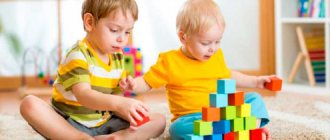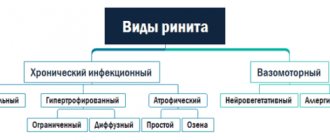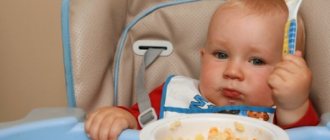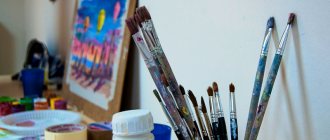What can a baby do at this age?
His speech is developing, now the baby can babble without stopping, pronouncing different sounds and syllables. He understands an adult and fulfills simple requests: “give me your hand,” “show me where the doll is.”
A child at 8 months clearly distinguishes between “friends” and “strangers”, is afraid of strangers or is wary of them. At the same time, he does not like to part with his mother, he cries and reaches out to her.
The baby already knows how to sit and is able to sit up on his own from a different position. Some kids are already standing up, pulling themselves up, and standing at the support. They can even take a few steps to the side, holding tightly to something. And yet, at this age, the baby is more accustomed to moving differently: he masters the “lower floor” - actively crawling on the floor.
In crawling, babies differ from each other, as in other skills. Some push off with their heels, others with their knees, and some even move backwards. Apparently it depends on how the child first managed to move. He remembered this and now repeats it.
Household skills are also developing. The baby learns to hold a mug and go to the potty. Eats well from a spoon with his mouth open. Don’t be upset if your baby doesn’t learn new actions well, repeat them patiently and don’t scold him for failures.
As already mentioned, all these skills simply need to be used. What games can you play with your baby? At this age, everything is a game for him. Any everyday moments can be played out, because if a child is passionate and interested in something, it is easier for him to master new types of activities.
What to do with the baby?
At this age, some toys will be especially useful for your baby:
- balls;
- sandbox set;
- a pair of dolls;
- rolling toys on wheels;
- spinning top;
- tumbler;
- cubes;
- a simple construction set with large parts;
- a set of bath toys;
- pyramid;
- simple sorter;
- set of cup inserts;
- matryoshka;
- sound toys (tambourine, piano, metallophone, drum, pipe, bell).
It is interesting for the baby to play with these objects: he inserts objects into one another, presses buttons, listens to sounds, rolls cars and balls, removes rings from pyramids. Mom can teach him how to care for a doll (and this is useful not only for girls).
What to do with a baby at home when mom needs to devote time to household chores? He can observe the process, listen or take part in what is happening as much as possible. For example, fiddling with flour or cereals, tapping a spoon on a pot or frying pan, covering dishes with appropriately sized lids, fidgeting with a cloth, “helping” mom clean up, imitating washing by rinsing a cloth or sponge in soapy water. Such imitative pastime contributes to the education of the future assistant.
And if the mother comments on everything that is happening (what she does for what, what she takes, what each item is for), such activities will actively contribute to the development of the toddler’s speech.
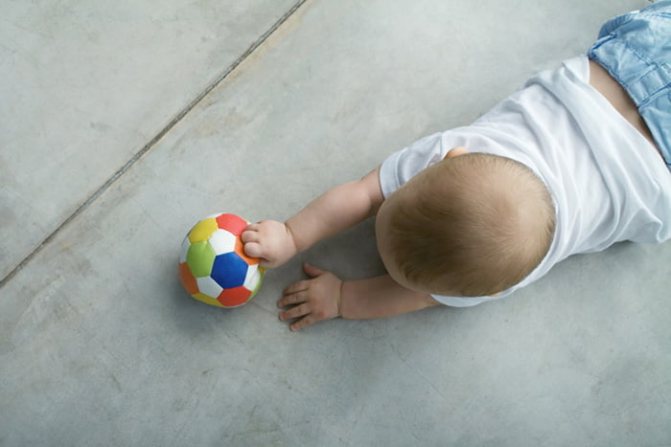
Games for physical development
Crawling is the best exercise. Cover the floors in the house with soft blankets and rugs, securing them at the edges to avoid wrinkles. Scatter your favorite toys on the floor at some distance from each other. The baby spends a lot of time crawling from one toy to another, and sometimes even falls asleep while playing. If the blanket is soft and there are no drafts, you should not disturb the baby, just cover it on top and leave it to sleep.
Active crawling
Encourage your baby to crawl in your direction by gently calling him, and when he gets there, hug and kiss him. The baby will be happy with his achievement. Remember, communication with an adult is the main incentive and driving force of development for a child.
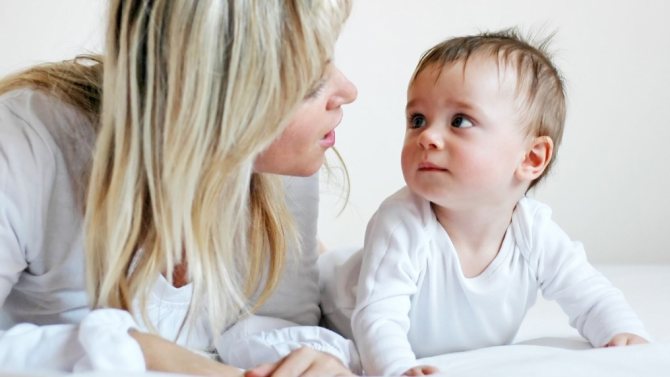
Catch-up
Imitating a chase, crawl along with your baby, saying: “I’ll catch up, I’ll catch up!” - urging him to crawl faster. Having caught up with the baby, throw it up a couple of times, and then repeat the game.
Overcoming obstacles
An “obstacle course” will help develop coordination. Make a mountain of pillows, a tunnel of large boxes, a cave of blankets. The baby, crawling and trying to overcome obstacles, will learn to correlate the size of objects, distance and his position in space.
We train to stand up
Prepare a highchair and tilt its back so that the baby, standing on all fours, grabs onto it. Lightly pull the chair so that the child first stands on his knees and then on his feet. You may have to press your baby's feet to the floor at first.
Let's try to walk
Give the baby your fingers and let him grab them tightly. Raise him to his feet and stand there. Praise him by telling him how big he is already, and he will enjoy this exercise. Then pull the arms towards you and let him try to take steps. Naturally, this needs to be done on a blanket, so that if the legs suddenly weaken, the baby will simply sit softly on his butt.
Training the ability to step over
All babies first learn to walk along a support, holding onto it with their hands. This could be a sofa, playpen, crib. When the baby is standing holding onto a support, lure him towards you with a toy, encouraging him to walk by stepping with his legs and grabbing his arms. If the baby has taken at least a step, but does not want to continue, give him the toy and praise him. Repeat the exercise later.
Learning to get down
Sometimes children who have learned to stand up cannot get back down onto all fours. To teach your baby, beckon him standing at a support with a toy. When he comes, lower the toy from the support to the floor or bottom of the crib, encouraging your baby to lower himself. If he doesn't succeed, help him bend first one knee, then the other.
Nastya, mother of one-year-old Matvey: “At 8 months, my son loved to show us performances on the TV, where the whole family usually gathered. A low, long cabinet with toys laid out on it is still his favorite place to play. He learned to walk by stepping along the bedside table, taking a toy one after another and showing it to us, turning it over in his hands, and telling us something in his own way. Everyone applauded. This is such a puppet theater.”
What to do with an 8 month old baby
March 2, 2013 admin Home page » Baby development

What to do with an 8-month-old baby is a question, the answer to which requires careful study, because it concerns your beloved baby and his physical, mental development, perception of everything around him and himself in the world around him. To make the process of getting to know the world around you a joy for your baby, let’s look at some activities that can be done at home. What to do with an 8-month-old baby (this applies to children from 6 to 10 months), we will consider further.
Children grow very quickly, before they even have time to look back, they are already sitting, they blink an eye, they are already crawling, and soon they will be walking, and what will they do - they will run! Starting from 6 months, you can already start studying with babies; this does not mean that it is time to teach reading or writing, just methodically repeat certain actions in a playful way, which sooner or later he will remember, master and repeat. Let's look at an example using an 8-month-old baby, because it is at this age that the “golden mean” can be traced - the baby already knows a lot, understands, but still does not fully control his actions and actions, it is at this time that it is best to start practicing in playful forms.
We keep the child occupied so that we can relax a little and develop fine motor skills.
toddler - give him a bag or bag of cereal, peas or pasta. You can purchase special toys aimed at developing fine motor skills, but as experience shows, children are more interested in ordinary, simple “bells and whistles.” You can also scatter bread crumbs, the baby will sort through and pick them up with ecstasy and zeal. At the age of 7, 8 and 9 months, children begin to take objects with their index finger and thumb, then twirl them in their palms and transfer them. Bags of cereal captivate babies no less than crumbs from the table, plus they also rustle, and when they fall, they make different sounds - all together they give the baby a lot of joy.
Rolling balls or throwing them
, if you constantly play with the ball, roll it along the floor with your baby, then by 9 months the child will realize that he needs to push in order for the ball to roll - for him this will be a great discovery, and for you another “victory”. Any balls are suitable, from small rag ones to large airy ones. The baby really likes light beach balls - they don’t stay in your hands, they constantly “run away” and it’s a lot of fun to catch up with them.
We tear
magazines, napkins, newspapers, in short, everything that is possible and that comes to hand. The kid tears with such zeal that it seems that he is inventing some kind of miracle device, his face is concentrated and very attentive, of course, he must tear it into small pieces. Just a month or two ago, he tore and immediately pulled all the pieces of paper into his mouth, but now he tears with force, examines the scraps, twirls them in his hands, then throws them and watches them fly - in a word, he develops strength, imagination and measures distances with his eyes.
Playing finger games
. Popular games at all times and for all peoples are “ladushki” and “magpie-white-sided”. These games will never lose their relevance. Ladushki - the little ones cheerfully and easily repeat, if you also sing along with the clapping, then in general it’s still such fun! Play every day and your child will clap and enjoy everything.
Sing, dance, blow, make faces, crawl and jump
– the baby will absorb everything like a sponge, and you won’t notice how he himself will start dancing and making faces. Talk to your child more, imitate him, by doing this you show him and tell him new words and actions, he watches how your lips move and over time he will begin to repeat. If you turn on the same collection of children's songs every day, the little one will remember them, and every time you turn them on he will smile and clap his hands.
All these activities are aimed at developing the perception of the surrounding world and you and your baby work together. If you don’t know what to do with an 8 (9, 10) month old baby while you are doing business, then you can use a playpen, a walker, or put pots and spoons in front of the child so that he drums, or put a box in front of him with different rags and ropes, all this will distract him for a while.
Whatever you come up with, remember, the main thing for the baby is your care and love, give him all your warmth, and he will thank you with his most sincere smile and his gentle touches.
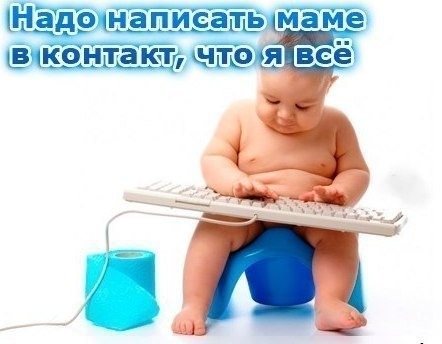
If you have anything to add or want to talk about your activities with kids, share with us, it will be very interesting to read. We are waiting for your comments!!
You can also read on this topic:
Mobile applications for children
How to decorate a first birthday
At what month do boys start sitting?
Tags: to help mom, useful toys, educational games, baby development, newborn development
Sensory development
Educational games for 8-month-old children at home are very simple and do not take up much mother’s time; you can use any available means in them.
On a walk
A child at eight months explores the world by touch, taste, learns to distinguish colors, sizes, and structure of materials. While walking, do not interfere with your baby’s research activities; let him play with sand, leaves, twigs, water, pebbles, and snow. Rolling in a stroller on a track will add little to development.
Toys from scrap materials
Give your baby several jars with twist-off lids and toys of different sizes. Let the baby open and close the lids, try to put toys inside and take them back out. This is how he learns to correlate the sizes of things: a small rubber ball fits into a jar, a large but soft scarf does the same, but a wooden cube does not. Accompany all games with your comments, indicating colors, names, sizes and properties of objects.
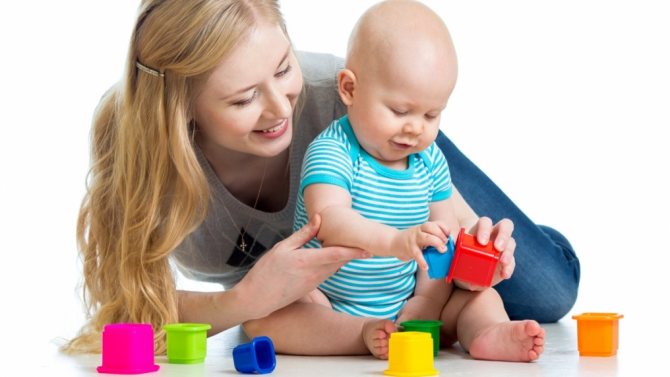
"Sensory treasure"
Provide your baby with a “sensory treasure” - a set of objects with different properties. Put there:
- a piece of fur (soft, warm, affectionate);
- pebbles (round, hard, cold);
- bump (prickly, hard);
- squeaking toy (elastic, squeaks loudly);
- nesting dolls (they open, and there is another one);
- bell (rings when shaken);
- a small mirror in a secure frame (it lets out glare, shines, you can see yourself) and so on.
How to play with these items? Take them out of the box one by one, offer to hold them, show them from all sides and tell them what these items are. Here's some fur, you can run it over your arms and face - it's very nice, the fur tickles. And if you take a cone, it pricks the handle, and at the same time it is light. Tell them that the cone grows on a tree in the forest, and show off its “sisters” during a walk. By going through these interesting things with mom, the baby will learn the properties of objects.
Important! Small parts can only be played with in the presence of an adult! Never leave your baby alone with dangerous objects.
Music games
Play music for your child, pick up toys for him that make sounds: a metallophone, a drum, a jar of dry peas, a tambourine. Show how to make sounds and have a “concert”.
The downside of many modern musical toys is the monotonous and annoying electronic screeching sounds. Be sure to check the sound of the toy before purchasing: it should be pleasant and melodic. Avoid harsh or startling lighting effects.
Singing
Singing is useful for developing an ear for music. Sing nursery rhymes to your baby while showing toys, such as bears:
Two bears came out to dance - Ta-ra-ra, ta-ra-ra! Thin Misha with fat Misha - Ta-ra-ra, ta-ra-ra! Slim Misha was exhausted - Ta-ra-ra, ta-ra-ra !And he fell on the fat man - Ta-ra-ra, ta-ra-ra!
Give toys to your baby, encouraging him to imitate the game he sees.
Maracas
Give your baby maracas in each hand. If you don't have any, make something similar using small bottles and filling them with peas. The task is to teach the child to feel the rhythm. Hum any rhymes, playing the rhythm, shaking the maracas:
I’ll harness the cat to the droshky, and the kitten to the tarantass, and drive along the path for all the kids to see!
Dancing
Hum a tune while clapping your hands and stomping your feet to the rhythm. Let the baby repeat:
Hands dance: Ta-ta-ta, Ta-ta-ta! This is how they dance: Ta-ta-ta, Ta-ta-ta! Legs dance Ta-ta-ta, Ta-ta-ta! This is how they dance: Ta -ta-ta, Ta-ta-ta!
Put bells on the child’s arms and legs, hold him by the arms, move him from side to side, stomp his feet:
Foot stomp, foot stomp Once again stomp, stomp again! Hand clap, hand clap, Once again clap, clap again!
Development of speech and expansion of knowledge about the world around us
How to develop a baby's speech at 8 months? Child development methods, in fact, cannot be divided into components. Any activity has its own purpose, but at the same time it contributes to the development of other qualities. The same “sensory treasure,” a massage session, and even feeding a child can be turned into an activity for speech development. It is enough just to communicate with the baby in the process. Pronounce the names of objects clearly and repeatedly, drawing the child’s attention to them: “Today we will eat from a green plate. Where is she? Here’s a green plate, let’s put some delicious puree in it.”
Mom of Slava, 8 months: “My son really liked to collect everything that was on the floor and give it to me. We called this game “Cleaning”. And he liked her so much that he began to pick up everything he could from the floor. He took it and then crawled towards me, and I named the object he brought. If there was nothing on the floor, I could pick up a piece of paper or thread and proudly hand it to my mother.”
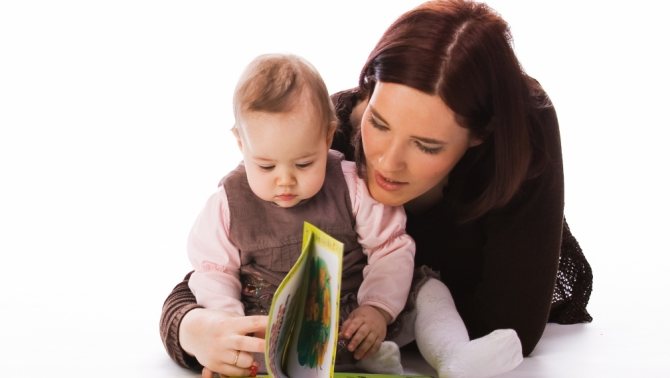
Read books
Pick up for your child several children's books with bright pictures and short rhymes or stories to accompany them. Look at the pictures, telling your child what is happening in them, what time of day is depicted, how the drawn character feels, what he says. The emotional speech of an adult means a lot to a child. This is how he finds out that mom feels sorry for Tanya, who dropped the ball, but at the same time calms her down. Say simple phrases during the game: “Give me the doll!”, “On the doll!”, “Where is the doll?”, let the child know what to do after these phrases.
"Show me where"
Ask your child to show where the doll’s eyes are (nose, mouth, arms, etc.). Then let him show the same thing to his mother and himself. Each time, confirm the correctness of the action: “that’s right, these are eyes,” and if you showed it incorrectly, correct it. The game can be made more difficult. Ask where the eyes are, for example, on a ball. If the child is confused, confirm that the ball does not and cannot have eyes. Be sure to praise your child for his intelligence.
Expand your baby's vocabulary by naming objects and after a while asking to show them. The baby, of course, won’t remember it right away, but if you repeat the same actions every day, the passive vocabulary will be significantly enriched.
For proper speech development, it is important to constantly dialogue with the child, but at the same time not to “fill” his head with information. Do not turn on the TV as a background: constant rapid speech, sharp sounds and flickering overload the baby's brain. The same thing with the radio, computer, toys.
Role-playing games
Role-playing games, where the heroes have different characters, are useful for developing imagination. Of course, the baby does not yet know how to play such games. Do it yourself. Play bear and fox: show how the bear speaks in a low voice, and the fox squeaks subtly. This will help the baby learn to distinguish the pitch of sounds and understand what artistic imitation is.
Finger games
Some games do not require toys at all, but their educational effect is enormous. For example, the well-known finger games. These include “ladushki”, “family”, “magpie-crow” and other well-known games. They represent simple movements (flexion/extension) of the fingers and hands with the recitation of simple rhymes.
Finger games combine the development of fine motor skills (active and passive movements), speech and phonemic hearing (rhythmic poetry). Start learning rhymes as early as eight months, and they will entertain and develop your baby until at least three years of age.
Family of mice
Mice live in a hole, (we put our palms together in “spoons” and look in) They sing songs loudly. (We bring our closed palms to our ears) The morning has come, the sun has risen! (twist with raised palms left and right) So daddy mouse woke up, (make a fist on one hand, bend and stroke the thumb) Here mommy mouse woke up, (bend and stroke the index finger) Here brother mouse woke up, (bend it back and stroke middle finger) Here the mouse daughter woke up, (bend and stroke the ring finger), Here the baby mouse woke up. (bend and stroke the little finger)
Hedgehog
A very cunning old hedgehog, (We fold our hands into a “lock”, but at the same time the fingers are straightened, forming spines) You won’t find what he hid (we make a negative gesture with the index finger) For our children, a mushroom (we clench one hand into a fist, put the second palm on top , forming a hat) The hedgehog hid it between the hummocks. (Hide your hands behind your back or between your legs)
Bear
The bear is sleeping in his den (we fold our hands in a “house” above our heads) We can’t find a way to him (we “go” with two fingers) Snow has covered everything around (we tap our fingers on the floor) Sleep quickly, you too are my friend. (we pretend to be asleep by placing our palms under our heads)
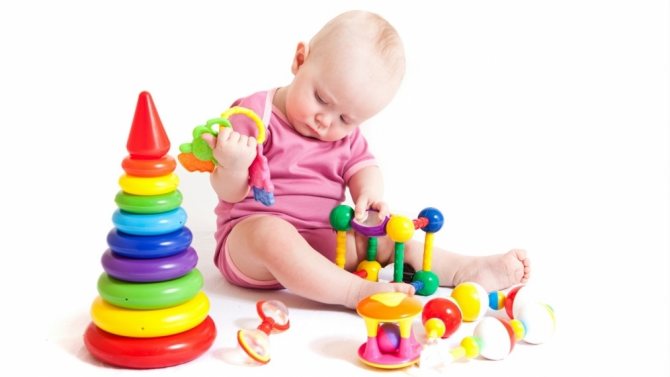
Rules for choosing toys
The simpler the toys, the better. Each should have one striking property that distinguishes it from the others. Don’t buy complicated expensive toys, the time has not come for them yet. Never scold your child for a broken toy: if he manages to break it, it means that it is either not built correctly or is not suitable for his age. Sometimes a broken toy can still perform its function.
Choose toys made from environmentally friendly materials and from trusted manufacturers. They should not have small parts that are easy to tear off. If it is an electronic toy, the batteries should be in a compartment secured with screws. Choose soft toys that can be washed. Remember: a child tastes everything. If you give him some “unchildish” thing to get to know, for example, an alarm clock, a telephone, and so on, do not leave the child alone with it, but put it in an inaccessible place.
The ideal toy is one that is used in different ways in different games. For example, the possibilities of a set of wooden cubes are practically unlimited. You can use them to make a ship, a house, a castle, a wall, a troll's cave, a rocket, and so on.
A typical set of toys for a child from six months to one and a half years:
- two balls (larger and smaller) + one with “spikes”;
- items for the sandbox (bucket, shovel, molds);
- several toys on wheels: cars of different sizes and a lolly ride for walking;
- 1-2 simple dolls, most similar to a person (soft hair of a natural shade, a favorable facial expression, preferably closing eyes);
- several toys depicting animals that are as similar as possible to real ones (a hare is gray, not purple, a red fox, a brown or white bear, etc.);
- children's dishes made of plastic;
- a simple construction set (preferably wooden) or a set of cubes;
- tumbler;
- sounding toys (drum, tambourine, bell, rattles, metallophone);
- bath toys;
- multi-colored cups and/or pyramid.
This is a basic set that can be expanded as desired. It is recommended to remove some toys and change them from time to time.
Remember that a child does not need many toys; the process of interaction with an adult is much more important. You shouldn’t hope to keep your baby occupied for a long time only with toys, he will quickly get bored. It is better to teach your child to imitate adults. This way you will not only teach your baby useful skills, but also find a good helper.
Proper interaction with toys
At the age of 8-9 months, the baby can no longer only look at or observe the mother’s actions during the game. He himself is already able to take an active part in games.
So what are the options for close interaction between the baby and various objects?
- We develop motor skills.
- We are building towers.
- Lace toys.
- Bottles.
- Putting the toys back in place.
It is very important to give the child freedom in his actions; do not impose your understanding. For example, don’t try to come up with your morals to a little one who has placed the rings in the pyramid in the wrong order or is placing the cubes on top of each other incorrectly. The mother should calmly explain and help, preferably using another pyramid and building her own tower, and not interfering in the baby’s process.
Developing motor skills
Give your child objects of different sizes, but comfortable to hold in his hand. If the mother is nearby and closely watches the baby, give him objects 3 cm in size. Spherical and cubic objects are suitable.
It is important to give your baby toys made of different materials; you can invite the baby to touch different textures of fabrics.
Building towers
It is very important to play with cubes. For the first time, mom will have to show how to build a tower. The baby will sit and enthusiastically watch her actions. It is also considered useful to show the baby that the building can be destroyed. It is better to do this with soft cubes, save the plastic ones for later (it will be painful for the baby to hit such cubes in order to destroy the turret). Very soon the child will want to build and destroy himself.
My friend’s daughter didn’t like to build, she waited for her mother to build a tower, and then in a second she destroyed everything and laughed.
Lace toys
At 8-9 months, children experience a period when they want to throw everything away: from the crib, stroller, box of toys. This process gives the baby considerable pleasure. But this begins to irritate mom, because she has to walk and constantly pick up everything that the little one has scattered. Before she had time to put it back where she had picked it up, the new toy was already flying to the floor. A way was found to avoid upsetting the child and to save the mother’s nerves. You need to tie toys that are, for example, in the crib with a cord to the railings or rods. Thus, the toys will not be able to fly far, and the baby will be able to return them to the crib on his own, simply by pulling the string.
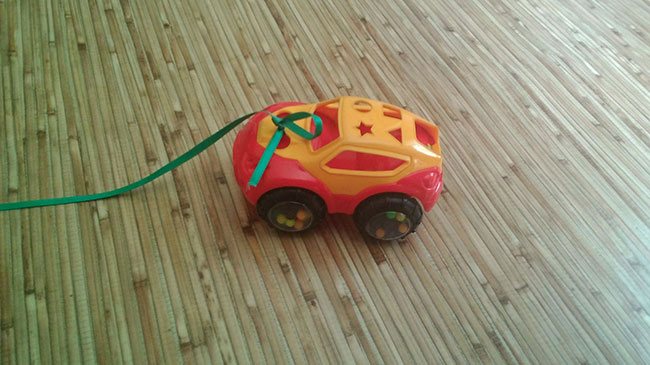
Bottles
An 8-9 month old baby will find it very interesting to watch and play with bottles if you place, for example, buttons of different sizes and shapes, beads, beans, coins in a transparent plastic container. They will not only amaze the child’s eyes with their diversity, but will also delight them with the sound they create.
